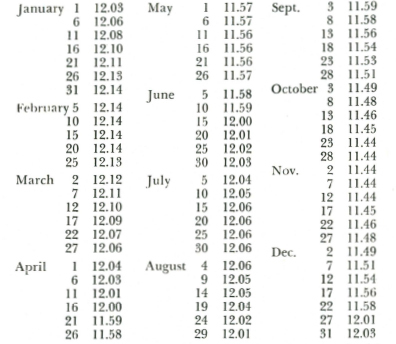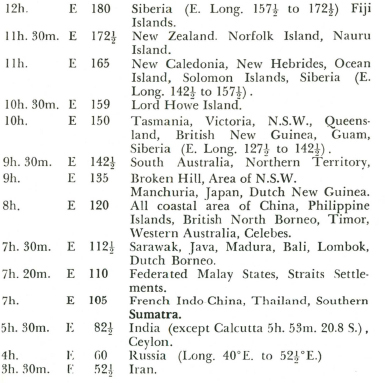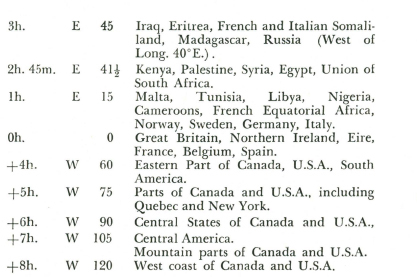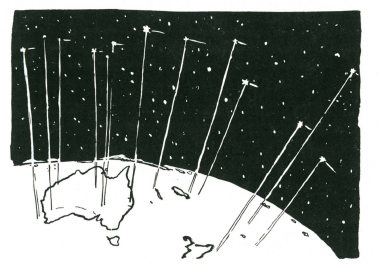A degree very nearly represents one division on the circumference over a radius of fifty-seven divisions of the same length. The angle of incidence of a ray of light equals the angle of reflection, so these two facts enable you to use this bush-made 'quadrant,' and with no knowledge of spherical geometry you can measure the angle of elevation of sun or stars with reasonable accuracy.
Place your eye against one of the divisions of the semicircle on the side farthest from the object to be viewed and looked at the surface of the water for the reflection. Move the free hand or pointer stick along the far side of the curve till it cuts off the ray of light from the heavenly body.
Count the number of divisions from the water to where the finger on stick cuts off the ray of light and also the number of divisions from the water to the one against which the eye was placed.
The total of these two will give you the angle of elevation above the horizon of the object viewed.

With care and accuracy in shaping your bow, and measuring the divisions you should be able to read to a quarter of a degree.
EQUATION OF TIME–and Corrections to Standard Time
Each day every longitude of the earth passes under the sun, but because of the slight variation in the earth's path, the exact moment when the sun passes over the meridian of longitude is not precisely at twelve o'clock every day. The difference may be as much as 16 minutes of time before twelve o'clock on your clock time and fourteen minutes after twelve o'clock.
This passage of the sun over the imaginary North-south line is called Meridian Transit’ and as you will see it differs from clock time throughout the course of the year, except for four days (April 16th, June 15th, August 30th, and December 25th).
For convenience, the time of meridian transit is averaged out over the year, and the average is called ‘mean’ time.
The sun’s passage of the meridian is called ‘solar’ (sun) time. The correction of time of the two is called ‘Equation of Time.’
The following simple table on Meridian Transit can be shown in the form of the figure ‘8’ for your easy memorising.
Time of Meridian Transit

A figure eight drawn to the proportions shown and with the four dates remembered when meridian transit coincides with mean time will give reasonably accurate corrections.
Note: The four dates when there is no correction are April 16th, June 15th, August 30th and December 25th, Xmas Day.
The top section of the figure 8 is about one-third the size of the lower half. The horizontal line is divided into three five-minute sections to right and left, and the right side marked PLUS to mean that the sun is ahead of mean time. The left is marked MINUS, the sun is behind mean time.
The application of this ‘Equation ot Time’ correction will be required if you want to get accurate time from the sun, and also for correction to the sun compass-sun clock.
LONGITUDE CORRECTIONS
The other correction which you will have to make to Solar time is a correction for longitude. Time for clocks on various parts of the earth’s surface is called ‘Standard Time,’ and is based upon the longitude convenient for a large tract of country.
In England, time is based on Greenwich, hence the term ‘Greenwich mean time.’
The areas of the earth and the meridian of longitude on which their standard time is based are as follows:
In other large land masses such as America, Africa, Russia and of course Australia, standard time may be defined as Eastern Standard Time, Central Standard Time, Western Standard Time, etc.
The areas of the earth and the meridian of longitude on which their standard time is based are as follows:


To make the necessary longitude corrections, you must know whether you are set East or West of the meridian on which standard time for the locality is based.
If you are East your sun will be ahead and you must deduct four minutes for each degree you are East of the meridian of standard time. If you are West your sun time will be later than the Standard Meridian and you must add four minutes for each degree you are West.
IMPORTANT
The corrections for the equation of time and for longitude are necessary to correct conversion of sun time to standard time for accurate direction, and also for accurate reading of directions and time from the sun compass. With these corrections you should be able to get local standard time to within two minutes, and a bearing accurate to within an error of one half degree, using no equipment whatsoever.
DAYLIGHT SAVING TIME
Sometimes a country will move its time back an hour from the standard time to get more daylight in summertime, and this change, generally called Daylight Saving Time, must also be remembered when making corrections to Solar time.
The four ‘Times’ you now know are:–
Solar Time or Sun Time: Local time of sun over the North-south line.
Mean Time: Average of Solar time over twelve months.
Standard Time: Application of Mean Time to a given area of the earth’s surface.
Daylight or Summer Time: A local adjustment to standard time.
There is a fifth ‘Time’ you will have to learn, and this is ‘Sidereal’ or ‘Star’ time.
If anyone asked you how many times the earth revolved on its axis between midday of New Year’s Day of one year, and midday of New Year’s Day the next year you would probably say 365¼ times ... and you would be wrong.
The earth revolves on its axis 366¼ times.
The earth ‘loses’ one revolution in its path around the sun over the year and as a result the sun only crosses the meridians of the earth 365¼ times. This means that while the sun will only cross Greenwich 365¼ times a year, a star, which is far outside the solar system will pass 366¼ times every year.
For this reason Star or Sidereal Time is used by astronomers as being more accurate than Solar Time.
There is an extra day to be squeezed into a ‘Star’ year, a star day is shorter by 3 minutes 56.6 seconds than a sun day You can work it out for yourself. There are 1440 minutes in a twenty-four-hour day and these have to be shared by all days in a star year and that means that there are nearly four minutes less in a star day than in a sun day.
One degree equals four minutes of time, and so the stars advance roughly one degree farther ahead each night.
Sidereal or Star Time or the star charts commence for each year at the day of the Autumnal Equinox, September 21st, and for general purposes you can say the stars gain two hours every calendar month.
ACCURATE TIME FROM THE STARS
The star maps show the position of the brightest stars in their various constellations. The numbers 0 to 24 indicate the position of the stars at midnight at Greenwich on September 21st, when the star year commences.
0 means midnight at Greenwich, and every number means one hour difference from Greenwich.
Thus ALGOL in the constellation PERSEUS is on the radial line numbered 3, which means that it is three hours ahead of Greenwich. (Chart 2.)
This position of the stars IN TIME from Greenwich is called their RIGHT ASCENSION, and their position between the poles and the Equator either North or South is called their DECLINATION.
Declination is latitude, and Right Ascension is longitude
The declination of the stars does not vary (as does the sun) throughout the year.
